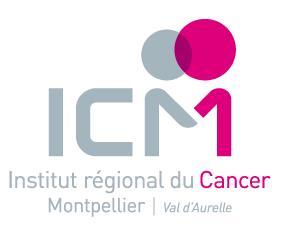Adapted EXTREME regimen in the first-line treatment of fit, older patients with recurrent or metastatic head and neck squamous cell carcinoma (ELAN-FIT): a multicentre, single-arm, phase 2 trial
Résumé
Background
A standard treatment for fit, older patients with recurrent or metastatic head and neck squamous cell carcinoma (HNSCC) is yet to be established. In the previous EXTREME trial, few older patients were included. We aimed to evaluate the efficacy and tolerance of an adapted EXTREME regimen in fit, older patients with recurrent or metastatic HNSCC.
Methods
This single-arm, phase 2 study was done at 22 centres in France. Eligible patients were aged 70 years or older and assessed as not frail (fit) using the ELAN Geriatric Evaluation (EGE) and had recurrent or metastatic HNSCC in the first-line setting that was not eligible for local therapy (surgery or radiotherapy), and an Eastern Cooperative Oncology Group performance status of 0–1. The adapted EXTREME regimen consisted of six cycles of fluorouracil 4000 mg/m2 on days 1–4, carboplatin with an area under the curve of 5 on day 1, and cetuximab on days 1, 8, and 15 (400 mg/m2 on cycle 1–day 1, and 250 mg/m2 subsequently), all intravenously, with cycles starting every 21 days. In patients with disease control after two to six cycles, cetuximab 500 mg/m2 was continued once every 2 weeks as maintenance therapy until disease progression or unacceptable toxicity. Granulocyte colony-stimulating factor was systematically administered and erythropoietin was recommended during chemotherapy. The study was based on the two-stage Bryant and Day design, combining efficacy and toxicity endpoints. The primary efficacy endpoint was objective response rate at week 12 after the start of treatment, assessed by central review (with an unacceptable rate of ≤15%). The primary toxicity endpoint was morbidity, defined as grade 4–5 adverse events, or cutaneous rash (grade ≥3) that required cetuximab to be discontinued, during the chemotherapy phase, or a decrease in functional autonomy (Activities of Daily Living score decrease ≥2 points from baseline) at 1 month after the end of chemotherapy (with an unacceptable morbidity rate of >40%). Analysis of the coprimary endpoints, and of safety in the chemotherapy phase, was based on the per-protocol population, defined as eligible patients who received at least one cycle of the adapted EXTREME regimen. Safety in the maintenance phase was assessed in all patients who received at least one dose of cetuximab as maintenance therapy. The study is registered with ClinicalTrials.gov
, NCT01864772
, and is completed.
Findings
Between Sept 27, 2013, and June 20, 2018, 85 patients were enrolled, of whom 78 were in the per-protocol population. 66 (85%) patients were male and 12 (15%) were female, and the median age was 75 years (IQR 72–79). The median number of chemotherapy cycles received was five (IQR 3–6). Objective response at week 12 was observed in 31 patients (40% [95% CI 30–51]) and morbidity events were observed in 24 patients (31% [22–42]). No fatal adverse events occurred. Four patients presented with a decrease in functional autonomy 1 month after the end of chemotherapy versus baseline. During chemotherapy, the most common grade 3–4 adverse events were haematological events (leukopenia [22 patients; 28%], neutropenia [20; 26%], thrombocytopenia [15; 19%], and anaemia [12; 15%]), oral mucositis (14; 18%), fatigue (11; 14%), rash acneiform (ten; 13%), and hypomagnesaemia (nine; 12%). Among 44 patients who received cetuximab during the maintenance phase, the most common grade 3–4 adverse events were hypomagnesaemia (six patients; 14%) and acneiform rash (six; 14%).
Interpretation
The study met its primary objectives on objective response and morbidity, and showed overall survival to be as good as in younger patients treated with standard regimens, indicating that the adapted EXTREME regimen could be used in older patients with recurrent or metastatic HNSCC who are deemed fit with use of a geriatric evaluation tool adapted to patients with head and neck cancer, such as the EGE.
Domaines
Cancer| Origine | Fichiers produits par l'(les) auteur(s) |
|---|---|
| licence |





